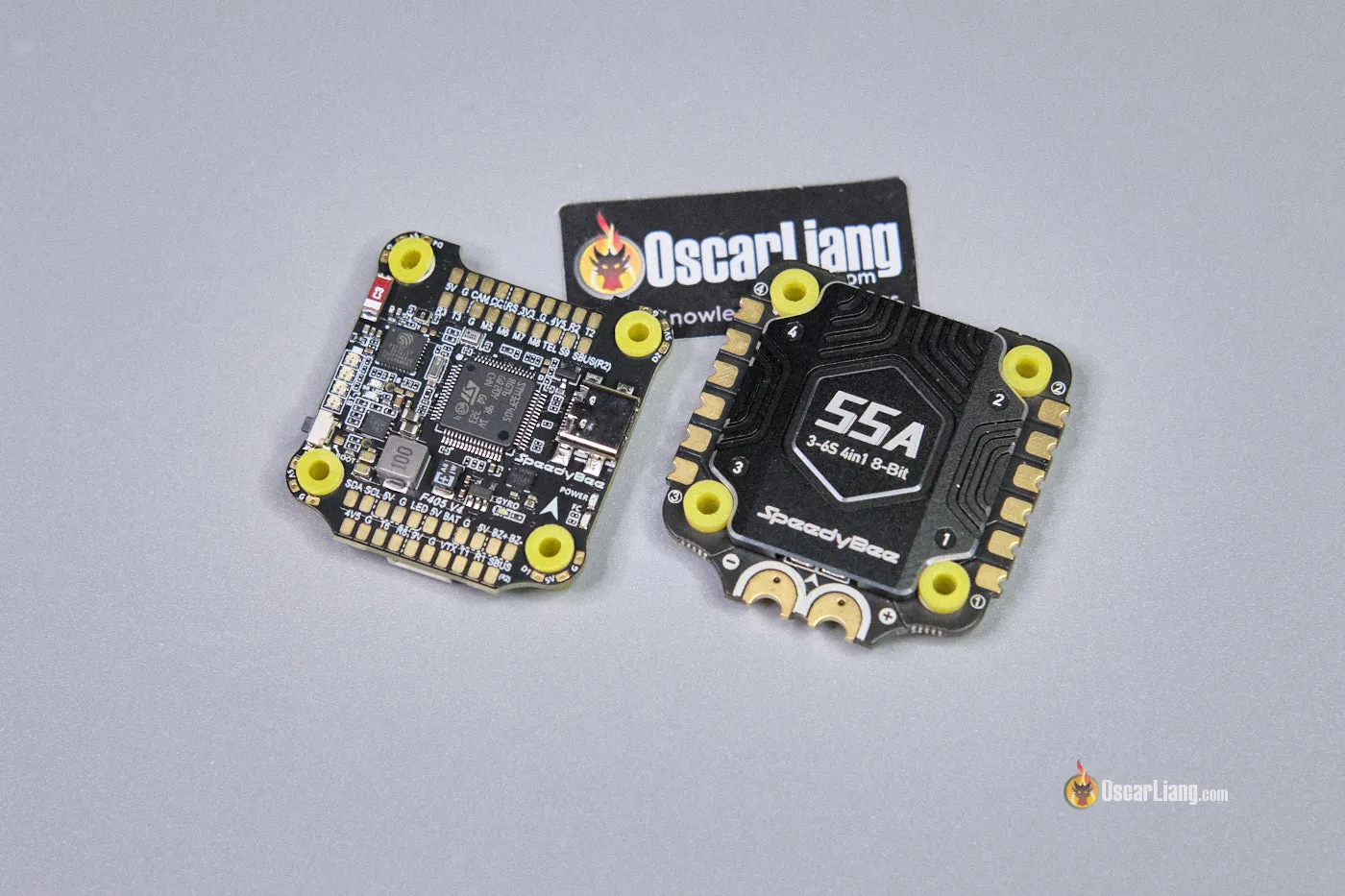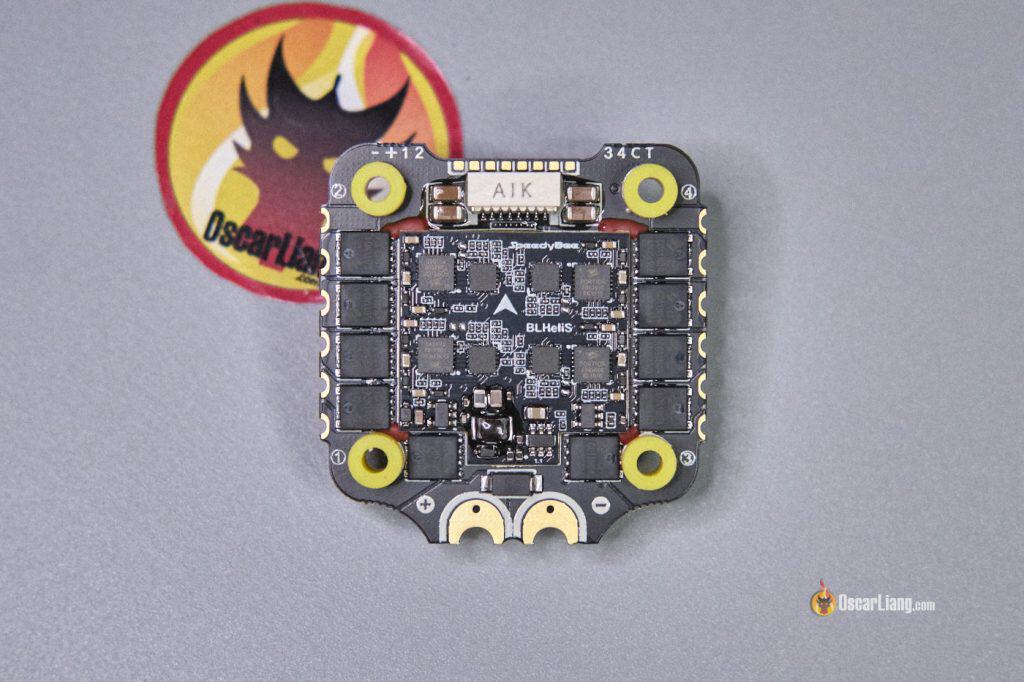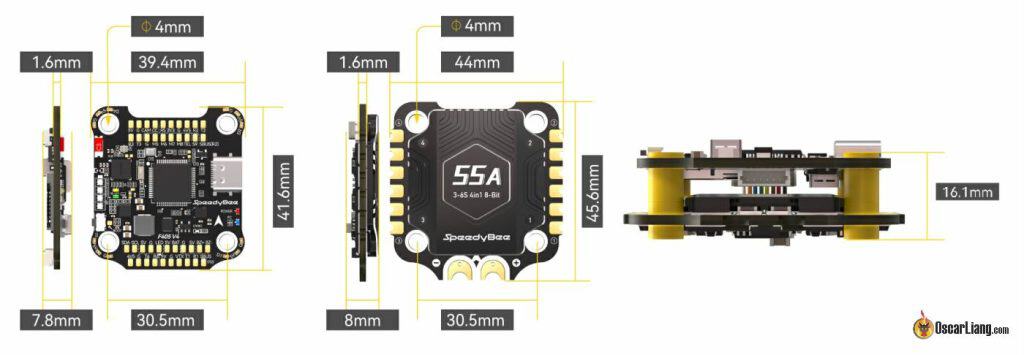The SpeedyBee F405 V3 stack has unquestionably earned its reputation as 2023’s most popular flight controller, thanks to its remarkable features with affordability. Now, SpeedyBee introduces the V4, aspiring to surpass its predecessor by offering enhanced features and superior build quality, all while maintaining the same price point. In this review, I’ll walk you through its distinctive features, specifications, and advancements made over the V3.
New to FPV? Check out my flight controller buyer’s guide.
Table of Contents
Where to Buy?
Get your Speedybee F405 V4 Stack from:
- AliExpress: https://s.click.aliexpress.com/e/_DFU9NkF
- Speedybee: https://oscarliang.com/product-wncw
- RDQ: https://oscarliang.com/product-6ro8
- GetFPV: https://oscarliang.com/product-bc57
- Amazon: https://amzn.to/46EzYZi
- FPV24: https://oscarliang.com/product-nqbg
In the box, you will find the following accessories:
- A 35V 1000uF low ESR capacitor.
- XT60 pigtail (12AWG).
- Cables for DJI air units, DJI O3 and Vista.
- Bolts, rubber spacers, nylon nuts for mounting.
Specifications
SpeedyBee F405 V4 Flight Controller
- MCU: STM32F405
- IMU(Gyro): ICM42688P
- USB Port Type: Type-C
- Barometer: Built-in
- Analog OSD Chip: AT7456E
- BLE Bluetooth: Supported (Used for Flight Controller configuration, MSP enabled with Baud rate 115200 on UART4)
- WIFI: Not Supported
- 6-pin HD FPV Connector: Compatible with DJI O3/RunCam Link/Caddx Vista/DJI Air Unit V1/Walksnail Avatar
- Blackbox MicroSD Card Slot: Supports SDSC and SDHC under 32GB. FAT16 or FAT32 format required.
- Current Sensor Input: Supported. For SpeedyBee BLS 55A ESC, scale = 400 and Offset = 0.
- Power Input: 3S – 6S Lipo.
- 6 UART
- 5V BEC Output 3A.
- 9V BEC Output 3A.
- 3.3V BEC Output 500mA.
- 4.5V BEC Output 1A.
- 8 ESC Signal Motor outputs: M1 – M4 on bottom side and M5-M8 on front side.
- ESC Telemetry: UART R5(UART5)
- I2C: Supported
- LED Pad: Supported
- Buzzer Pad (BZ+ and BZ- pads): Supported
- BOOT Button Available
- RSSI Input: Supported
- Frsky SmartPort / F.Port: Not Supported
- Supported Flight Controller Firmware: BetaFlight (Default), INAV
- Firmware Target Name: SPEEDYBEEF405V4
- Mounting: 30.5 x 30.5mm (4mm hole diameter, requires 3mm bolts due to rubber gummies)
- Dimension: 41.6(L) x 39.4(W) x 7.8(H)mm
- Weight: 10.5g
SpeedyBee BLS 55A 4-in-1 ESC
- Firmware: BLHeli_S J-H-40
- Continuous Current: 55A x 4
- Burst Current: 70A x4 (10 seconds)
- TVS Protective Diode: Yes
- Supported ESC Protocol: DShot300, DShot600
- Power Input: 3-6S LiPo
- Current Sensor: Supported (Scale=400, Offset=0)
- ESC Telemetry: Not Supported
- Mounting: 30.5 x 30.5mm (4mm hole diameter, requires 3mm bolts due to rubber gummies)
- Dimension: 45.6(L) x 44(W) x 8(H)mm
- Weight: 23.5g
Value for Money
The standout feature of the SpeedyBee F405 stack has always been its unmatched value. For $69.99, you are getting a feature-packed flight controller and a decent 4in1 ESC that can match the performance of pricier alternatives. The introduction of the V4 sees an upgrade in the ESC from 50A to 55A and brings a suite of refinements to the FC.
Design and Build Quality
At first glance, the V4 might look similar to the V3, both have the iconic yellow rubber gummies for soft mounting and dark PCB color. The board layouts are pretty similar with large solder pads that are easy to work with.
One notable enhancement is the aluminum alloy heatsink in the 4-in-1 ESC, improving not only the cooling and durability but also giving it a premium feel. This ESC heatsink was previously exclusive to the more expensive SpeedyBee F7 V3 stack.
Enhanced Features
The SpeedyBee F405 V4 stack introduces several enhancements, let’s take a look.
New Gyro
The MCU on the flight controller remains an STM32F405, same as the V3, however, they changed the Gyro from BMI270 to ICM-42688P, and it appears Speedybee nailed the implementation. They’ve integrated a dedicated power supply for this gyro and added a 100uF tantalum capacitor, minimizes interference from reaching it from the power source, promises cleaner gyro data and simplifying PID/Filter tuning.
With the latest Betaflight firmware, both gyros offer decent performance. However, some manufacturers prefer one over the other due to cost and availability. Learn more about gyro here: https://oscarliang.com/flight-controller/#Gyro
SD Card Reader for Blackbox
One of the main concerns with the V3 was the SD card problem. The OSD chip and the SD card shared a pin on the processor, which led to compatibility issues with newer versions of Betaflight. Thankfully, with the V4, SpeedyBee has resolved this issue by giving all devices their separate SPI. This means you can enjoy blackbox logs without any glitches, a significant relief for many pilots.
Full DShot Support in iNav
The older V3 used to have issue with DShot due to DMA configuration which is a downer for iNav users. This has been resolved in the V4, offering native supports for DShot on all 8 motor outputs, making it fully compatible with iNav.
Enhanced BEC Outputs
The integrated 5V and 9V BEC have been upgraded from 2A to 3A. This upgrade is crucial for users of high-power HD systems, providing more flexibility and stability in power management.
Enhanced 4in1 ESC
The 4-in-1 ESC has undergone significant enhancements, now boasting a rating of 55A, up from the prior 50A, and a surge capacity of up to 70A. The addition of a metal heatsink and the selection of MOSFETS with lower internal resistance are excellent improvements, aimed at managing heat more efficiently during demanding flights. A built-in TVS diode for surge protection reduces voltage spikes. It’s built with thicker 3 ounces of copper layer in its PCB, 50% increase from previous version, providing additional reliability and heat dissipation capbility.
While these enhancements almost double the weight of the 4-in-1 ESC to 23.5g, from the V3’s 13.8g, the trade-off is worthwhile for those prioritizing reliability.
Other Notable Features
Wireless Configuration
Regardless of price, almost every flight controller from SpeedyBee is equipped with onboard Bluetooth modules. This feature enables users to wirelessly configure their flight controller and ESC via the “SpeedyBee” app installed on their mobile phones. This feature makes PID tuning in the field quick and straightforward, eliminating the need for a computer.
FPV System Compatibility
This stack is designed to be compatible with both digital and analog OSD, ensuring versatility.
The V4 flight controller is plug-and-play for all available DJI video transmitters, including the DJI O3, Full size air unit and Runcam Link (Caddx Vista), cables are provided in the kit for all these VTX’s.
This FC is also compatible with all other HD systems, such as the Walksnail Avatar and HDZero. However cables for these systems are not provided, so you might have to do some extra wire soldering on your own.
Battery Level Indicators
The flight controller features onboard LED lights on the side, serving as handy battery level indicators, eliminating the need for a separate battery checker.
Wiring Diagrams
Conclusion
The SpeedyBee F405 V4 Flight Controller Stack stands out with its impressive specs, user-friendly features, and exceptionally appealing price point.
Regardless of your desired configuration and applications – be it freestyle flying or long-range explorations, quadcopter, hexacopter or octocopter, this stack has you covered.
Get your Speedybee F405 V4 Stack from:
- AliExpress: https://s.click.aliexpress.com/e/_DFU9NkF
- Speedybee: https://oscarliang.com/product-wncw
- RDQ: https://oscarliang.com/product-6ro8
- GetFPV: https://oscarliang.com/product-bc57
- Amazon: https://amzn.to/46EzYZi
- FPV24: https://oscarliang.com/product-nqbg
- Sep 2023 – article created.
- Apr 2024 – Updated.











11 comments
Hi Oscar, just got one of these and following your How to Build guide, DJI version. The V4 FC has an SBus connector where the V3 had BAT. In your instructions you say ‘You won’t connect the SBUS and GND pads in the Vista’ Does this apply to the V4 too? I plan on using the plug into the FC from the Link.
If you are using ExpressLRS receiver like I did in the build log, then you won’t need to connect the SBUS pad.
Hi, Oscar! I discover problem with this Speedybee F405 V4 A55. I tried to connect the servo, but it doesn’t work (I use the servo for the gimbal camera). I’ve already updated the firmware, and it doesn’t work. I tried creating an experiment and chose Speedybee F405 V3 on the same settings and it works correctly. Maybe you met with this problem too? Thank you so much for any help!
Well… I bought 2 F405 V3 stack’s, neither one off them seems to be compatible with the Dji O3 unit. No OSD or battery voltage In the Integra goggles. Tryed everything, doesn’t work. Controls work doh. Any tips?
Sounds like you didn’t setup DJI OSD correctly. Not sure if you followed my instruction here? https://oscarliang.com/dji-o3-air-unit-fpv-goggles-2/#OSD
Double check UART (TX/RX) connection, if in doubt try swapping them and see.
All good, but I hope that they have fixed the issue with the usb breaking off. This is a common issue of the v3.
I have three v3 units here and two v4. Never happened anything with USB, let alone breaking off. Where did you buy yours? I’d seriously reconsider that re-seller.
The V3 had 2 hardware flaws:
1: A shared SPI bus conflict which made the OSD disappear when using Blackbox SD card logging at the same time. They tried to pretend it was a “microsd card compatibility issue” which is BS.
2. It was advertised as supporting S.Port/FPort, again didn’t work and they silently edited the official specs to “Not supported”.
This V4 (alledgedly, need an actual review) fixes 1. and show S.Port/Fport as “Not supported” without lying.
Oh and the “SpeedyBee” app is a closed-source fork of Betaflight configurator which is illegal under the GPL V3 license.
The rest are welcomed hardware improvements but keep in mind what kind of company you’re supporting with this.
former speedybee f405 v3 was plagued with design flaws. I will not buy anything from Runcam anymore. Those people cannot be trusted.
I’m new to drone building and your take is contradictory to everything I’ve seen. I’m interested in learning more. What company/ products do you recommend instead of the companies you mentioned? Why? I’m genuinely curious? I have no dog in the fight, just wanna build a quality drone, using quality parts, from quality companies.
Thanks!
I hope DShot doesn’t fall off when connecting something else on I2C?